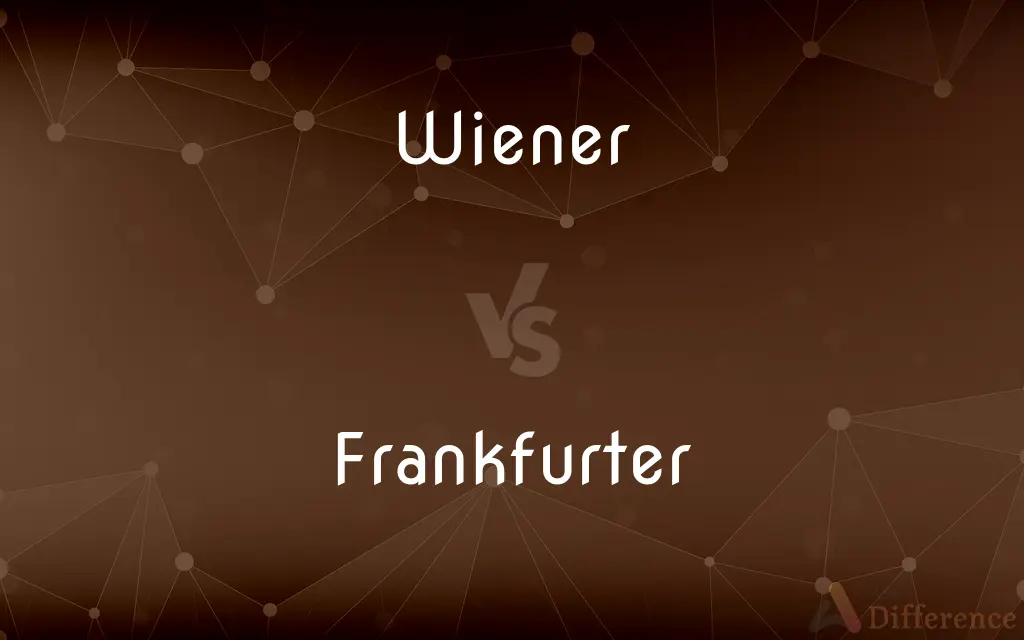Wiener vs. Frankfurter — What's the Difference?
Edited by Tayyaba Rehman — By Fiza Rafique — Updated on April 6, 2024
Wiener and Frankfurter are both types of sausages, with the former being Austrian and often lighter, while the latter originates from Frankfurt, Germany, and is typically more heavily seasoned.

Difference Between Wiener and Frankfurter
Table of Contents
ADVERTISEMENT
Key Differences
Wieners, originating from Vienna (Wien in German), Austria, are smooth-textured sausages made from a mixture of pork and beef. Frankfurters, on the other hand, hail from Frankfurt, Germany, and are traditionally made from pure pork. These geographic origins not only influence their names but also hint at their culinary roots and traditional recipes.
The preparation of wieners involves smoking and then cooking, resulting in a sausage that is light in color and delicate in flavor. Frankfurters, whereas, are known for their darker color and richer, more pronounced flavor, owing to the different preparation methods and seasoning blends used.
In terms of consumption, wieners are often associated with the famous Viennese dish Wiener Schnitzel, despite the term also referring to the sausage itself. Frankfurters are commonly served with bread, mustard, and sometimes sauerkraut, reflecting traditional German tastes.
The texture of wieners is typically finer and smoother, appealing to a different culinary preference compared to the coarser texture found in some varieties of frankfurters. This difference in texture influences how each sausage is best enjoyed, with wieners often favored in dishes where a delicate texture is preferred.
Culturally, both wieners and frankfurters have been adopted and adapted in various cuisines around the world, often leading to confusion between the two. However, their distinct origins and characteristics continue to influence how they are used in traditional and modern recipes alike.
ADVERTISEMENT
Comparison Chart
Origin
Vienna, Austria
Frankfurt, Germany
Meat Composition
Typically a mixture of pork and beef
Traditionally pure pork
Flavor
Lighter and more delicate
Heavier and more heavily seasoned
Preparation
Smoked and then cooked
Varies, but often involves a similar smoking process
Common Serving
Often served in dishes like Wiener Schnitzel or as a standalone sausage
Commonly served with bread, mustard, and sometimes sauerkraut
Texture
Smooth and fine
Can be coarser depending on the variety
Cultural Adaptation
Adapted into various global cuisines but remains a staple in Austria
Widely adopted and adapted, especially in American hot dogs
Compare with Definitions
Wiener
Versatile in culinary uses, it can be found in various traditional and modern recipes.
The chef used Wieners to create a modern twist on the classic Viennese dish.
Frankfurter
A traditional German sausage made from pure pork, known for its rich flavor and darker color.
At the German market, he couldn't resist buying a pack of authentic Frankfurters.
Wiener
Often served as part of traditional Austrian dishes or as a standalone snack.
For lunch, she had a Wiener served with a side of mustard and freshly baked bread.
Frankfurter
Can have a coarser texture compared to Wieners, contributing to its distinct eating experience.
The coarse texture of the Frankfurter added an enjoyable bite to the dish.
Wiener
Known for its fine and smooth texture, which distinguishes it from other sausages.
The fine texture of the Wiener made it particularly enjoyable.
Frankfurter
Heavily seasoned for a rich and pronounced taste, distinguishing it from lighter sausages.
The Frankfurter's bold flavors were a perfect match for the spicy mustard.
Wiener
A smooth-textured sausage originating from Vienna, Austria, made from a blend of pork and beef.
He ordered a Wiener at the Austrian restaurant, expecting the delicate flavor he loves.
Frankfurter
Has influenced various cuisines, notably the American hot dog.
The festival featured Frankfurter-inspired dishes from around the world.
Wiener
Smoked and then cooked to achieve its characteristic light color and texture.
The Wiener was smoked to perfection, making it a highlight of the meal.
Frankfurter
Typically served with bread and mustard, reflecting traditional German tastes.
Their picnic included Frankfurters with all the traditional accompaniments.
Wiener
A frankfurter or similar sausage.
Frankfurter
A smoked sausage of beef or beef and pork made in long reddish links.
Wiener
Wienerwurst.
Frankfurter
A moist sausage of soft, even texture and flavor, often made from mechanically recovered meat or meat slurry.
Wiener
A frankfurter.
Frankfurter
A smooth-textured sausage of minced beef or pork usually smoked; often served on a bread roll
Wiener
(North America) A sausage made from beef, chicken or pork.
Wiener
A frankfurter, a hot dog.
Wiener
A person who is nervous or afraid to partake in certain activities.
Wiener
An irritating or disliked person.
Wiener
United States mathematician and founder of cybernetics (1894-1964)
Wiener
A smooth-textured sausage of minced beef or pork usually smoked; often served on a bread roll
Common Curiosities
Can Wiener and Frankfurter be used interchangeably in recipes?
While they can sometimes be substituted for each other, their distinct flavors and textures might alter the intended outcome of the recipe.
How should Wieners and Frankfurters be stored?
Both should be kept refrigerated and consumed by the use-by date on the packaging; if cooked, they should be stored in an airtight container and eaten within a few days.
What's the main difference between a Wiener and a Frankfurter?
The main difference lies in their origin and flavor profile; Wieners are Austrian and generally lighter, while Frankfurters are German and more heavily seasoned.
Are Wieners always made from a mix of pork and beef?
Traditionally, yes, but variations exist, especially in different culinary traditions that may use different meat blends or even vegetarian alternatives.
Why are Frankfurters often associated with American hot dogs?
American hot dogs were influenced by German immigrants who brought their sausage-making traditions, including Frankfurters, to the United States, adapting them into what we now know as the hot dog.
Is there a vegetarian version of these sausages?
Yes, vegetarian and vegan versions of both Wieners and Frankfurters are available, using plant-based ingredients to mimic the texture and flavor of the traditional meats.
What makes the texture of Wieners different from Frankfurters?
The texture difference is due to the meat grinding process and ingredients; Wieners are generally smoother, while Frankfurters can be coarser.
What are some traditional sides to serve with Wieners and Frankfurters?
Traditional sides include mustard, bread, sauerkraut, and in some cases, potato salad or fries.
Can Wieners and Frankfurters be eaten raw?
Since they are pre-cooked, they can technically be eaten without additional cooking, but they are usually heated for flavor and safety reasons.
How have Wieners and Frankfurters been adapted in cuisine outside of Europe?
They've been adapted in various ways, from the American hot dog to being ingredients in a wide array of international dishes.
Are there any health considerations with consuming Wieners and Frankfurters?
As with all processed meats, consumption should be moderate due to concerns about saturated fats, sodium, and preservatives like nitrates.
Share Your Discovery

Previous Comparison
Leprechaun vs. Fairy
Next Comparison
Cranky vs. MoodyAuthor Spotlight
Written by
Fiza RafiqueFiza Rafique is a skilled content writer at AskDifference.com, where she meticulously refines and enhances written pieces. Drawing from her vast editorial expertise, Fiza ensures clarity, accuracy, and precision in every article. Passionate about language, she continually seeks to elevate the quality of content for readers worldwide.
Edited by
Tayyaba RehmanTayyaba Rehman is a distinguished writer, currently serving as a primary contributor to askdifference.com. As a researcher in semantics and etymology, Tayyaba's passion for the complexity of languages and their distinctions has found a perfect home on the platform. Tayyaba delves into the intricacies of language, distinguishing between commonly confused words and phrases, thereby providing clarity for readers worldwide.
















































